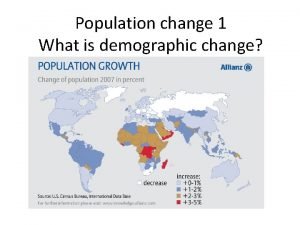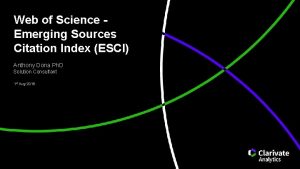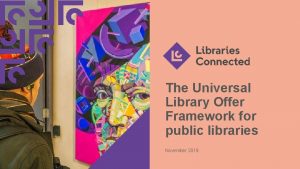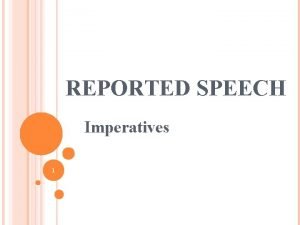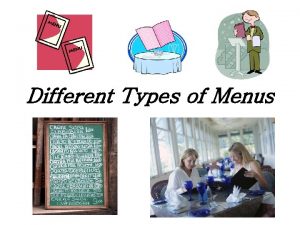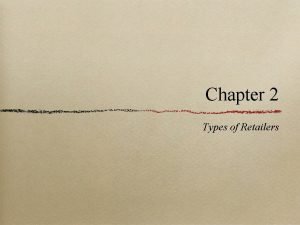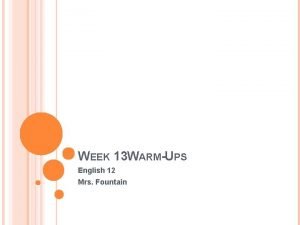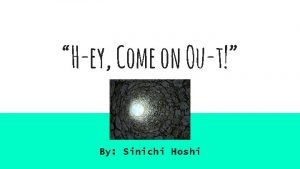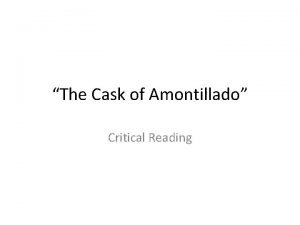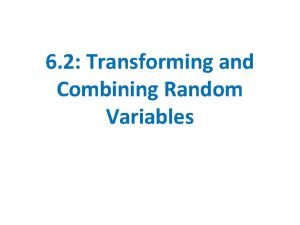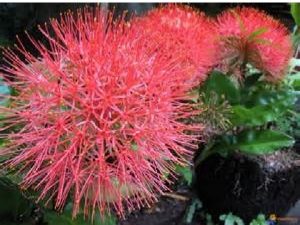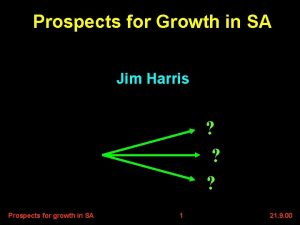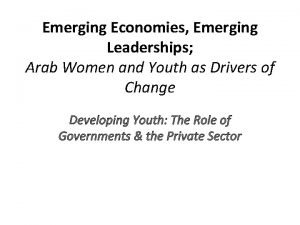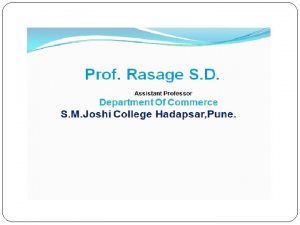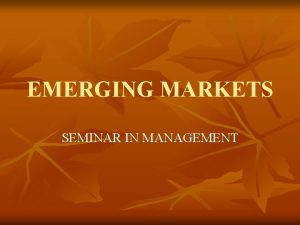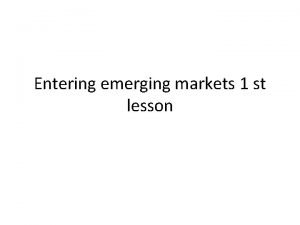The Prospects that Emerging Science Offers Us for




























































- Slides: 60

The Prospects that Emerging Science Offers Us for Longer Healthy Lifespans March 26, 2013 Kopriva Lecture Montana State University Presentation by: Vincent E. Giuliano, Ph. D. Agingsciences. com

TOPICS � State of the sciences of aging � Some important things we know about aging ◦ Consequences of aging ◦ Aging, diseases and healthspan � What about extending human lives? ◦ Possible societal benefits ◦ Epigenetics � Practical steps for Living 10 - 20 years longer �Conventional wisdom �Focus on diet – Nrf 2 pathway �Focus on stress management – hormesis ◦ Breaking through the 122 year age limit �Stem cell science

State of science – The relevant scientific literature is vast � Understanding Image source Growth in Pub. Med. org publications Now around 20. 5 million indexed research publications aging takes us into just about every area of human biology and medicine More than a million new publications every year

Composite network of molecular pathways active in HCV-infected liver tissue.

State of the science Purine metabolism – image source Image source � � � There are thousands of such diagrams to be found in the literature not all consistent, mostly unconnected with other related diagrams The research tends to be solid but extremely complex. Because of this, researchers in one field usually don’t follow the literature in possibly-related fields.

The context – State of the science � Understanding aging takes us into just about every area of human biology and medicine � The field is incredibly broad and deep � It consists of many disparate areas of studies � Most scientists are only partially aware of what other scientists producing related results are doing, or are unaware So, what is presented here is story my own of what is known about aging

Where are we in aging research? - Overall � AMOUNT AND DEPTH OF DETAIL IS ASTOUNDING – A HUMAN IS BY FAR THE MOST COMPLEX ENTITY KNOWN IN THE UNIVERSE � LIKE PUTTING TOGETHER A 30 MLLION PIECE MULTIDIMENSIONAL JIGSAW OF AGING AND THE PATHWAYS INVOLVED IN AGING

Where are we in aging research? - Overall � WE ARE ASSEMBLING SUB CHUNKS OF THE PUZZLE WITHOUT KNOWING HOW THEY WILL ALL EVENTUALLY FIT TOGETHER ◦ WE DON’T HAVE A GUIDING PICTURE ON THE BOX COVER � � WE HAVE ENOUGH BIG SUBCHUNKS TO MAKE MANY OF US THINK THAT THE PUZZLE WILL BE COMING TOGETHER SOON WE UNDERSTAND A LOT ABOUT THE CONSEQUENCES OF AGING AND THE PATHWAYS INVOLVED IN AGING

We know a lot about the consequences of aging � We are living longer Survival curve is becoming rectangular Image source

We know a lot about the consequences of aging � It is fatal � Everybody so far dies by age 122

We know a lot about the consequences of aging � Efficiency and regulation of key body systems declines with advancing age ◦ Stem cell senescence and decreased cell differentiation capability ◦ lessened immune responses ◦ Decline in key hormones ◦ Decreases in numerous key proteins ◦ Decreased antioxidant defenses ◦ Decreased DNA repair capabilities

We know a lot about the consequences of aging ◦ Metabolic pathways less efficient ◦ DNA gets methylated ◦ Histones get deacetylated ◦ Molecular signaling pathways becomes less efficient ◦ Activation of key health genes decreases ◦ Activation of cancer and other disease-related genes increases ◦ More and more DNA damage The list goes on and on Incremental deecripitude!

� Consequences of aging With declines there is a steep rise in susceptibilities to age-related diseases � Cancers, cardiovascular diseases, diabetes, Alzheimer’s Disease, Parkinson’s Disease, etc. Alzheimer’s Disease Image source

� Consequences of aging With aging there is a steep rise in susceptibilities to age-related diseases, e. g. cancers Image source

The aged consume far greater health care resources Cost of fall injuries by age group Image source A growing world-wide problem Image source

About extending human lifespans and healthspans ◦ The theories and views of aging and stream of new discoveries give many clues as to how to extend human lives ◦ Having us live longer lives is an easier matter to grapple with than fully understanding aging (which probably requires fully understanding biology)

WE KNOW HOW TO SLOW AGING DOWN IN LOWER ANIMALS BUT ARE NOT SURE ABOUT HUMANS � Several aging interventions have worked in more primitive animals: ◦ C-elegans, extending lifespans by a factor of up to 8 ◦ Drosophila melanogaster ◦ Mice and rats, up to almost double � Often these have required interventions not practical for humans ◦ E. g. genetic interventions

Some important insights � An important observation of all the animal longevity experiments is that lifespans and healthspans go together ◦ Double the lifespan of an animal and they will still die of the same causes and diseases ◦ They will get the diseases and die of them much later. � This leads to a whole different way of thinking about degenerative diseases. � Aging now thought to be not only a risk factors for age-related diseases but a causal factor for such diseases.

Where are we regarding age-related diseases? • Suggests a shift in research strategy from seeking cures of diseases of old age to research focused to slowing aging and delaying onset of such diseases • This could make a lot of sense because progress in curing degenerative diseases of old age has been extremely slow. Despite spending hundreds of billions on research on them over many decades

ECONOMIC AND SOCIAL BENEFITS OF INCREASING LIFESPANS COULD BE ENORMOUS If we could delay aging an average of 10 years the economic health care and increased productivity benefits would be immense Everybody moves back 10 years on the health care cost curve

The increase in life spans is happening anyway The life expectancy curve is being rectangularized Image source Social security act passed 1935 Average US life expectancy 64 Now. Average US life expectancy 80. 5

� EXTENDING QUESTIONS HUMAN LIVES DIVIDES INTO TWO 1. WHAT CAN WE DO TO EXTEND AVERAGE HUMAN LIFESPANS 10 -20 YEARS, FURTHER RECTANGULARIZING THE SURVIVAL CURVE BUT RESPECTING THE 122 YEAR HUMAN AGE LIMIT? � We know that some people live 10 -20 years more than others. How can we move ourselves individually and the general population to living the longer lives? 2. WHAT MIGHT WE DO TO BREAK THROUGH THE 122 YEAR AGE LIMIT SO PEOPLE CAN LIVE 150 OR HUNDREDS OF YEARS? � Woah! This would mean breaking some very basic rules.

How about that additional 10 -20 years? – my opinions Speeding up the process of adding another 10 -20 years to our lifespans is probably entirely achievable – further rectangularizing the life expectancy curve Applying conventional wisdom about health can go a long ways in this direction, even for older adults • For most people, genetic background need NOT be a major factor (more on this later) • It can be done by paying attention to lifestyle, diet, exercise, stress management, and the judicious use of plant-based dietary supplements • Pharmaceuticals now in the pipeline could also help

How about that additional 10 -20 years? – my opinions • I believe going for that extra 10 -15 years is now largely a personal choice, of being one of those who dies sooner, or one of those who dies later. • Not everybody knows they have that choice. • Picking the longer lifespan requires learning and following some rules with discipline • The interventions are simple but involve patterns of gene activation – they have epigenetic impacts.

Epigenetics/Epigenomics ◦ Once not very long ago we thought that once we sequenced the genes in the human genome we would be ready to understand biology, diseases and aging. ◦ After all, genes make our proteins, and that is what we are all about We were wrong

Epigenetics/Epigenomics � � We now know that the genes in the nucleus of a cell contain only a small portion of the information there in the DNA. The rest of the information controls which genes are activated and when. It is called epigenetic information ◦ After all, all the cells in a body contain the same genes. ◦ And most of our genes are the same as those in mice or apes ◦ In both cases the differences are mainly due to which genes are activated � � Gene activation patterns change throughout life and with aging So, more and more researchers now grasp that we need to go far beyond genetics to epigenetics to understand what is going on in biology and aging.

Epigenetic information is encoded: In the long sequences of DNA between genes, once thought to be “junk DNA” (nc. RNA coding) � In how genes are silenced by being methylated � In how tightly DNA is wrapped around the spindles (histones) in cells (histone acetylation) � Compared to some 25, 000 genes there are millions of epigenetic marks. Most remain unknown. � Epigenetics is providing a whole new way of looking at biology, diseases and biology �

How about that additional 10 -20 years? Lifestyle � Mostly a matter of conventional wisdom, e. g. advice of popular book and TV gurus like Dr Oz. ◦ Regular exercise ◦ Good rhythms of sleep and rest ◦ Rich social, intellectual and physical life ◦ Careful attention to diet ◦ Use of dietary supplements ◦ Attention to stress management � However, in the last three categories there is also important unconventional wisdom

Attention to diet (conventional wisdom) � Plant-based Mediterranean diets best – fresh vegetables and fruits, fish � Minimize intake of sugar or simple carbohydrates that turn to sugar � Minimize meat consumption � Better smaller meals earlier in the day � Pay attention to omega-3 vs omega-6 balance � The same advice as for avoiding diabetes, insulin resistance, cardiological problems, cancers, Supported by much research: pathway studies, animal studies as well as human epidemiological studies.

Less-conventional health wisdom: Take advantage of phytosubstances and the Nrf 2 molecular pathway

Nrf 2 and what you eat � Nrf 2 is a genetic transcription factor. It has to do with what genes are turned off or on (epigenetic activation). ◦ Nrf 2 appears to be a master regulator of cellular responses to oxidative damage and other stressful conditions. ◦ When Nrf 2 is activated it turns on some 240 healthproducing genes. � � These genes activate the body’s own powerful antioxidant responses, inhibit excess inflammation, inhibit cancer progression, detoxify poisons, etc. Nrf 2 can be turned on by many plant-based foods that contain certain phytochemicals, and by taking dietary supplements that contain those phytosubstances

Nrf 2, diseases and health � Increasing Nrf 2 expression can help prevent, ameliorate or clear up numerous age-related health problems in a variety of species, problems ranging from Type 2 diabetes to ischemic stroke, to cancers to cardiovascular problems to recovery from physical injuries.

Examples of common dietary flavinoids that activate Nrf 2: � � � � Anthocyanidins: (Cyanidin, Delphinidin, Malvidin, Pelargonidin, Petunidin) Red, blue, and purple berries; red and purple grapes; red wine Flavanols: (Catechin, Epicatechin, Epigallocatechin Epicatechin gallate, Epigallocatechin gallate), Teas (particularly green and white), chocolate, grapes, berries, apples, black and oolong) Theaflavins: (Thearubigins, Proanthocyanidins ) Chocolate, apples, berries, red grapes, red wine Flavanones (Hesperetin, Naringenin, Eriodictyol) Citrus fruits and juices, e. g. , oranges, grapefruits, lemons Flavonols (Quercetin, Kaempferol, Myricetin, Isorhamnetin) Widely distributed: yellow onions, scallions, kale, broccoli, apples, berries, teas Flavones (Apigenin, Luteolin) Parsley, thyme, celery, hot peppers Isoflavones (Daidzein, Genistein, Glycitein) Soybeans, soy foods, legumes

Many of these plant-based substances promote health and longevity not only by activating Nrf 2 but through other pathways as well � For example, many have other gene-activating (epigenetic) health-producing activities including: ◦ Activating DNA repair genes ◦ Inhibiting inflammatory pathways ◦ Changing DNA conformation to sure that protective anti-cancer genes are expressed ◦ Embedding their plant RNA in your RNA to make sure you remain protected ◦ Creating stress signaling (hormetic responses) in cells

Focus on stress management: Health and longevity advice: � Avoid � Not exactly. Think again! � You need and can benefit from stress � � But you need to manage stresses and keep them within limits The body of science involved is called hormesis

“Was mich nicht umbringt, macht mich starker. ” Friedrich Nietzsche “What does not kill me, makes me stronger”

Introduction to Hormesis – starting with the needs of evolution � Organisms have evolved so they function best with certain amounts of key stresses, not in the absence of stresses. ◦ Organisms are shaped and limited by the stresses they encounter in their environments. Hormesis is about stress and how organisms adapt to deal with stress. � Biological systems react to stress in a nonlinear fashion so as to restore balance. � The essence of hormesis is that, within a certain quantitative “window” of amount of stress, any biological organism and its subsystems mount strong defenses and � as a result is better off than if there were no stress at all. �

Stress has a dual character � At high doses stresses create damage � At low dose levels, stresses promote body defenses that make you stronger and healthier

Introduction to Hormesis – the dose-response curve Risk, Damage Health � � the horizontal axis depicts level of applied stress, say as driven by ROS load in a cell. The vertical axis represents relative risk, level of probable pathological organism response where normal level is 1.

Hormesis is a universal property of biological systems � It applies to virtually all biological organisms on the levels of cells, organs and whole organisms � It applies to all known forms of stress, e. g. ◦ Radiation, Inflammation, Exercise, Cold. Heat ◦ Dietary restriction, Absence of key nutrients ◦ Blood flow restriction, Pathogens, oxidative stress, Mental/emotional stress � It operates through multiple well-studied biological pathways ◦ The Nrf 2 pathway is one of them

�Some ◦ ◦ ◦ familiar examples of hormesis Immunization by vaccines Ischemic preconditioning; “Grit” training Exercise training Radiation hormesis No risk

IMPORTANT GENERAL PROPERTIES OF HORMESIS 1. Dose response is critical – the general curve seems to always apply though its quantitative parameters will vary widely 2. Timing and duration of stressor is critical. ◦ Cannot be for too long. ◦ Works best when synchronized with circadian time windows For hormetic behavior, stressors must be pulsed; cannot be constant. 3. ◦ Periods of rest and recuperation essential.

IMPORTANT GENERAL PROPERTIES OF HORMESIS (continued) 4. Stress responses are limited by stress pathways activated; Multiple stressors may produce no better responses than single ones 5. Repeated cycles of hormetic stress changes parameters of stress response curve and makes organism capable of handling higher and higher levels of stress E. g. exercise training, high-altitude accommodation

Hormesis as a personal health intervention � The key is not avoiding stress; it is managing stress � This means welcoming the stresses of life – they help us live longer � It also means making sure that they lie within the personal hormetic ranges � The stresses that can be managed include: ◦ Heat and cold ◦ Exercise, necessary within limits ◦ Endurance-demanding activities ◦ And lots of others

In the course of a typical day, we have numerous minor hormetic experiences, e. g. me Feb 13, 2013 • Cold semi-naked in bedroom and bathroom morning – cold shock pathway • Blueberries, walnuts and phytosubstances supplements for breakfast– Nrf 2 pathway • Frustration stress related to a computer help line conversation – cortisol, multiple pathways • Minor fight with my wife - same pathways • Exercising/shoveling snow/treadmilling – PGC 1 pathway • Trying to figure aging and biology out – BDNF and related pathways.

In the course of a typical day, we have numerous minor hormetic experiences, e. g. me Feb 13, 2013 (continued) • Chain sawing, fumes, gas spilled on my hand – Nrf 2 pathway - phase II detoxifying enzyme genes via AREs. • Pepperoni snack containing nitrites – same pathway • More plant-based supplements during day • Supper included salmon with olive oil, garlic, ginger, oregano and a touch of pepper sauce, broccoli and mixed greens – After supper, for desert I munched on 80% coco chocolate – Nrf 2 path again • Bedroom/bathroom icy cold again at night – cold shock again

Practical personal stress management to keep it hormetic Stress management techniques known to be effective Image source

Also, pharma interventions are being studied that could possibly add some to human lifespans � Key longevity-related molecular pathways ◦ The m. TOR pathway �Activated by the drug Rapamycin ◦ The Klotho pathway �Klotho is an anti-aging and disease-combatting gene and protein ◦ The IGF 1 -FOXO 3 pathway �Moderated by exercise, sirtuins, resveratrol and resveratrol analogs ◦ Modulating these has extended lives of small animals ◦ Mostly, interventions not practical for humans �E. g. genetic interventions ◦ Personally I doubt that these will get us significantly further than the interventions already mentioned. ◦ They certainly won’t get us beyond the 122 year limit

WHAT MIGHT WE DO TO BREAK THROUGH THE 122 YEAR AGE LIMIT? � The answer, if any, will lie in integrative newscience approaches beyond conventional wisdom � Molecular biology ◦ study of biology at a molecular level. Overlaps with biology, chemistry, genetics and biochemistry. � Epigenetics/Epigenomics ◦ Critical information not in the genes themselves ◦ Gene activation pathways � Hormesis again ◦ Lessons of long-lived species � Stem cell science ◦ Induced pluripotent stem cells ◦ Adult somatic stem cells, autologous stem cells

HORMESIS AND AGING The hormesis pathways have a lot to do with longevity of individuals and of species Experiments with lower species indicate that lifespans of lower species can be enhanced via inducing hormesis, e. g. • Drosophila via repeated application of mild heat stress • Multiple stressors in Caenorhabditis elegans • Up to 40% life exension in C-elegans due to heat shock • Multiple species via calorie restriction • Multiple species via radiation Image source

HORMESIS AND AGING Some very-long lived species are exposed to repeated hormetic shocks and have markedly upgraded stressresponse pathways, e. g. Bristle cone pines is the world’s longest-lived non-clonal species, with livespans of up to 5, 000 years • Grow on mountains between 5, 600 and 11, 200 feet, White Mountains, California • Subject to strong and highly variable stresses: cold temperatures, dry soils, high winds, short growing seasons, and constant hypoxia • Water/moisture stress a major factor • Very disease resistant • Needles alone may last 40 years

HORMESIS AND AGING -- Some very-long lived species are exposed to repeated hormetic shocks and have markedly upgraded stress-response pathways, e. g. The naked mole rat lives eight times as long as comparable-size mice and can live up to 30 years �Lives in conditions of hypoxia, high carbon dioxide, acidification, excrements, urine, wars between colonies • Shows little decline due to aging, maintains high activity, bone health, reproductive capacity, and cognitive ability throughout its lifetime. • Never get cancers, the main killer of mice • Has incredible hypoxic response. Can withstand brain oxygen deprivation for more than 30 minutes • Exhibits mutation in the specificity of HIF 1 a • Has six times the amount of endogenous expression of the hormetic anti-oxidant defense protein Nrf 2. • Has high endogenous levels of NRG-1, P 16

How about bats? � � � Compared with other mammals of similar size, bats live a long time, with lifespans of between 20 and 40 years. Rats live between 2 and 3 years, on average Despite living in dank, dark, dung-filled caves, bats only rarely get sick or are debilitated by infections Out of more than 5, 000 types of mammals on the planet, bats are the only one capable of sustained flight and some species can fly more than 1, 000 km in a single night. Such exertion entails great free radical stress Bats have evolved to have powerful free radical defenses and DNA repair systems

These and many other long-lived species experience repeated hormetic stresses and have remarkable stressresisting defenses. � Raises the questions: ◦ What role do repeated hormetic stress experiences play in the longevity of very long-lived species? ◦ Are there additional ways for us to use hormesis so we can live longer and healthier? Or, lack of stress?

Stem cell sciences – focus on i. PSCs and regenerative medicine � � A major body of research in recent years has been Induced Pluripotent Stem Cells (i. PSC): creating them, engineering them for practical applications, applying them for regenerative medicine An i. PSC is functionally almost exactly like an embryonic stem cell that can be created for an individual by chemically/transcriptionally reverting any normal body cell back to “pluripotent” state Technologies are being perfected for taking a skin or blood cell, reverting it back to i. PSC status, multiplying it, and then inducing it to differentiate into particular body cells, like heart cells, liver cells, blood cells, etc. These cells are being experimentally used in animals to regenerate organs

� Cells derived from i. PSCs might be used for many kinds of disease cures Image soiurce Cells derived from i. PSCs are patient’s own cells and will not face immune system rejection Image source

The Stem Cell Supply Chain APOPTOSIS Diseases, aging, death

APOPTOSIS FEWER Less aging, diseases, Longer lives Closing the loop in the stem cell supply chain could conceivably lead to longer lives. Hopefully this could be induced inside the body. Proposed in 2010. Steady research progress since then.

Selected blog publications www. agingsciences. com � � HORMESIS ◦ Multifactorial hormesis - theory and practice of maintaining health and longevity, Sarcopenia - the Age-related Los of Muscle Mass and Function Part I: Pathways and factors, ◦ The Hormetic Wild Animal Zoo and Their Zookeepers, ◦ Mitohormesis, ◦ Radiation hormesis, ◦ Mitochondria Part 2: Mitochondrial Responses to Stress: Mitochondrial Signaling: Survival and Death Pathways, ◦ Hormesis and age retardation NRF 2 PATHWAY ◦ The pivotal role of Nrf 2: Part 1 - a new view on the control of oxidative damage and generation of hormetic effects, ◦ The pivotal role of Nrf 2: Part 2 - foods, phyto-substances and other substances that turn on Nrf 2, ◦ The pivotal role of Nrf 2. Part 3: Part 3 - Is promotion of Nrf 2 expression a viable strategy for human healthspan and lifespan extension? , PHYTOSUBSTANCES AND HORMESIS ◦ Plant polyphenols - six epigenetic knockout punches against cancers, HORMESIS PATHWAYS ◦ HSP 70 to the rescue

The Prospects that Emerging Science Offers Us for Longer Healthy Lifespans March 26, 2013 Kopriva Lecture Montana State University Presentation by: Vincent E. Giuliano, Ph. D. Agingsciences. com
 In line 2 impatient of is best interpreted as meaning
In line 2 impatient of is best interpreted as meaning Phân độ lown
Phân độ lown Quantum computing: progress and prospects
Quantum computing: progress and prospects Block nhĩ thất độ 2 mobitz 1
Block nhĩ thất độ 2 mobitz 1 Thể thơ truyền thống
Thể thơ truyền thống Thơ thất ngôn tứ tuyệt đường luật
Thơ thất ngôn tứ tuyệt đường luật Walmart thất bại ở nhật
Walmart thất bại ở nhật Tìm vết của mặt phẳng
Tìm vết của mặt phẳng Hãy nói thật ít để làm được nhiều
Hãy nói thật ít để làm được nhiều Tôn thất thuyết là ai
Tôn thất thuyết là ai Prospects of agriculture in bangladesh
Prospects of agriculture in bangladesh World population prospects
World population prospects Gây tê cơ vuông thắt lưng
Gây tê cơ vuông thắt lưng Sau thất bại ở hồ điển triệt
Sau thất bại ở hồ điển triệt Prospects preposition
Prospects preposition Web of science emerging sources citation index (esci)
Web of science emerging sources citation index (esci) My favourite subject is science because
My favourite subject is science because Universal library offers
Universal library offers Reported speech advice
Reported speech advice Different types of menus
Different types of menus How an organization offers unique customer value
How an organization offers unique customer value Variety and assortment examples
Variety and assortment examples Amadeus offers
Amadeus offers All things considered being a senior offers a student
All things considered being a senior offers a student Summary of the story hey come on out
Summary of the story hey come on out At the end of the story what makes montresor feel sick
At the end of the story what makes montresor feel sick A firm that offers outsourcing solutions is called a
A firm that offers outsourcing solutions is called a 29 cfr 1910
29 cfr 1910 Xmpp development
Xmpp development Explain the classes of wtp
Explain the classes of wtp I stand all amazed at the love jesus offers me
I stand all amazed at the love jesus offers me Absa bond repayment holiday
Absa bond repayment holiday Uac december round 2 cut off
Uac december round 2 cut off Combining random variables
Combining random variables Fspos vägledning för kontinuitetshantering
Fspos vägledning för kontinuitetshantering Typiska novell drag
Typiska novell drag Nationell inriktning för artificiell intelligens
Nationell inriktning för artificiell intelligens Returpilarna
Returpilarna Varför kallas perioden 1918-1939 för mellankrigstiden
Varför kallas perioden 1918-1939 för mellankrigstiden En lathund för arbete med kontinuitetshantering
En lathund för arbete med kontinuitetshantering Personalliggare bygg undantag
Personalliggare bygg undantag Vilotidsbok
Vilotidsbok Sura för anatom
Sura för anatom Vad är densitet
Vad är densitet Datorkunskap för nybörjare
Datorkunskap för nybörjare Boverket ka
Boverket ka Tes debattartikel
Tes debattartikel Magnetsjukhus
Magnetsjukhus Nyckelkompetenser för livslångt lärande
Nyckelkompetenser för livslångt lärande Påbyggnader för flakfordon
Påbyggnader för flakfordon Vätsketryck formel
Vätsketryck formel Offentlig förvaltning
Offentlig förvaltning I gullregnens månad
I gullregnens månad Presentera för publik crossboss
Presentera för publik crossboss Teckenspråk minoritetsspråk argument
Teckenspråk minoritetsspråk argument Plats för toran ark
Plats för toran ark Klassificeringsstruktur för kommunala verksamheter
Klassificeringsstruktur för kommunala verksamheter Epiteltyper
Epiteltyper Bästa kameran för astrofoto
Bästa kameran för astrofoto Cks
Cks Programskede byggprocessen
Programskede byggprocessen











